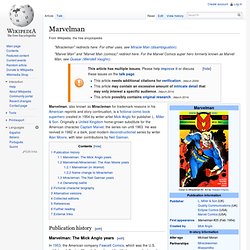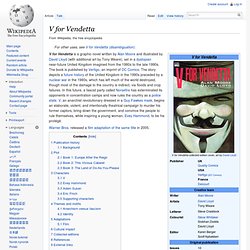

Superman: Whatever Happened to the Man of Tomorrow? Moore wanted his plot to honor the long history of the character and to serve as a complete conclusion to his mythology.[2] The story is a frame story set ten years after Superman was last seen, where Lois Lane recounts the tale of the end of Superman's career to a reporter from the Daily Planet.

Her story includes numerous violent attacks against Superman by his enemies, the public revelation of his secret identity of Clark Kent and a number of deaths of those closest to him. The story has been cited as one of the best stories of the character of Superman,[3][4][5][6] and critics and audiences frequently choose it as one of the most memorable comics ever published.[7] It is used as an example of how to close the long-time continuity of a comic book character. The story's legacy has endured with similar stories written as tributes to it.
Marvelman. Publication history[edit] Marvelman: The Mick Anglo years[edit] In 1953, the American company Fawcett Comics, which was the U.S. publisher of Captain Marvel, discontinued the title because of a lawsuit from DC Comics.[1][2] Len Miller and his company L.

Miller & Son, Ltd. had been publishing black and white reprints of the series, along with other Fawcett titles, in the UK, and rather than stopping he turned to comic packager Mick Anglo for help continuing or replacing the comic.[3] They transformed Captain Marvel to Marvelman while Miller continued his other Fawcett reprint titles and used logos and trademarks that looked significantly like Fawcett's. [citation needed] This added to the appearance that the Fawcett line was continuing, and that Marvelman was still Captain Marvel, in order to retain the audience. [original research?] Mick Anglo's association with Len Miller ended in 1960. At the height of their success, the British "Marvels" saw a series of Italian reprints. V for Vendetta.
Publication history[edit] When the publishers cancelled Warrior in 1985 (with two completed issues unpublished due to the cancellation), several companies attempted to convince Moore and Lloyd to let them publish and complete the story.

In 1988, DC Comics published a ten-issue series that reprinted the Warrior stories in colour, then continued the series to completion. The first new material appeared in issue No. 7, which included the unpublished episodes that would have appeared in Warrior No. 27 and No. 28. Tony Weare drew one chapter ("Vincent") and contributed additional art to two others ("Valerie" and "The Vacation"); Steve Whitaker and Siobhan Dodds worked as colourists on the entire series. Background[edit] David Lloyd's paintings for V for Vendetta in Warrior originally appeared in black-and-white. Cover of Warrior#19, highlighting the comic's conflict between anarchist and fascist philosophies. Plot[edit] Book 1: Europe After the Reign[edit] Book 2: This Vicious Cabaret[edit] Watchmen. Moore used the story as a means to reflect contemporary anxieties and to critique the superhero concept.

Watchmen depicts an alternate history where superheroes emerged in the 1940s and 1960s, helping the United States to win the Vietnam War. The country is edging towards a nuclear war with the Soviet Union, freelance costumed vigilantes have been outlawed and most former superheroes are in retirement or working for the government. The story focuses on the personal development and struggles of the protagonists as an investigation into the murder of a government sponsored superhero pulls them out of retirement, and eventually leads them to confront a plot that would stave off nuclear war by killing millions of people.
Creatively, the focus of Watchmen is on its structure. Gibbons used a nine-panel grid layout throughout the series and added recurring symbols such as a blood-stained smiley face. Publication history[edit] Background and creation[edit] Alan Moore on the basis for Watchmen[9]